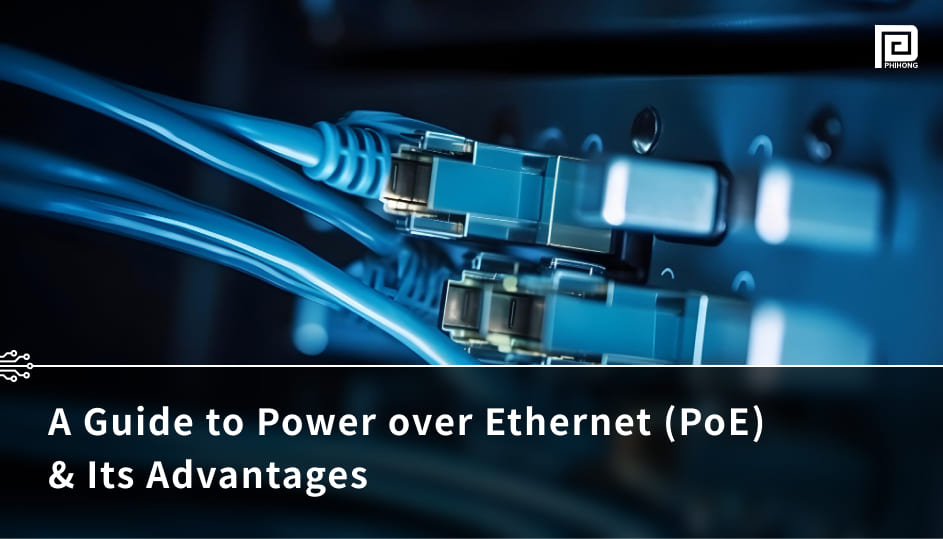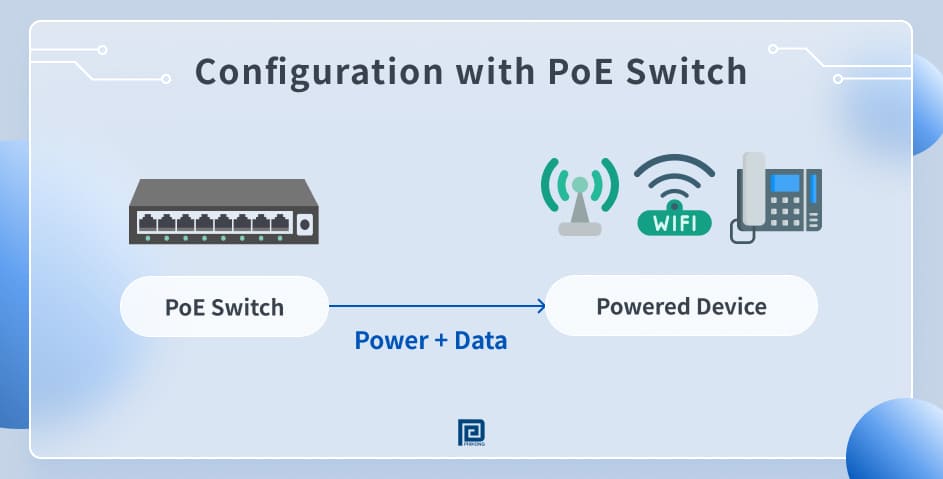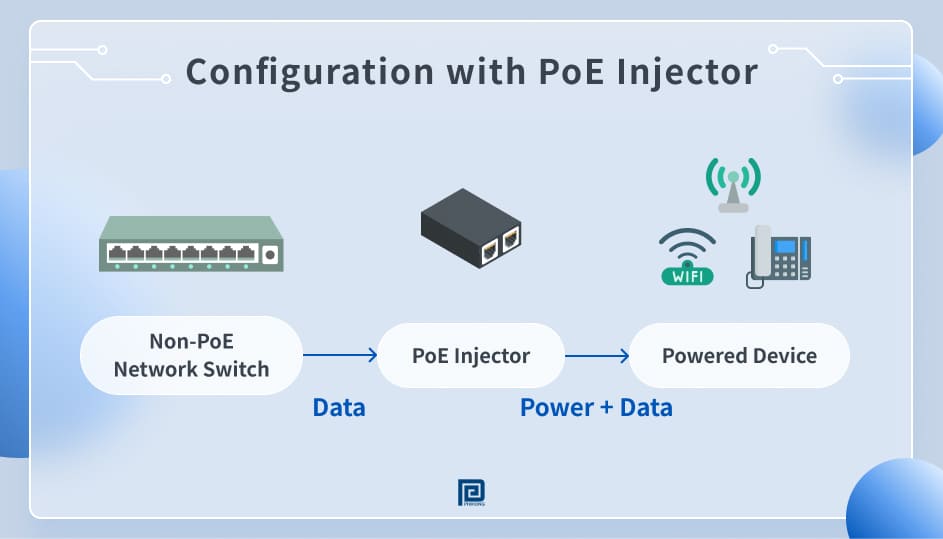Power over Ethernet (PoE) transmits data and power over a single cable, simplifying networks. Learn more about PoE benefits, standards, and applications below!
1. What is PoE – Power over Ethernet and How Does PoE Work?
Power over Ethernet (PoE) is a revolutionary technology that transmits both data connection and electric power over a standard Ethernet cable. This eliminates the need for separate power supplies for devices like IP phones and security cameras, resulting in a more cost-effective and manageable network setup. It also offers greater versatility compared to traditional systems, allowing network devices to be installed in various locations, even when electrical circuitry is unavailable.
Additionally, PoE is standardized by the IEEE (Institute of Electrical and Electronics Engineers), an international organization that focuses on developing and promoting a wide range of industry standards to ensure safe usage and interoperability. This means that PoE devices adhere to strict regulations, which allows them to offer a high level of reliability during application.
Another thing to note is that PoE systems usually consist of two main components, the power sourcing equipment (PSE) and the powered devices (PD), which act as the transmitter and receiver respectively. We’ll explain their features as well as what PoE is used for below, before discussing the different PoE types, and the benefits and limitations of using PoE.
1.1. What is Power Sourcing Equipment (PSE) ?
The PSE is the heart of a PoE system, as it is in charge of supplying power to compatible PDs. Common types of PSEs include the PoE switch and PoE injector, and each of them are suited for different applications, so users have to choose the right one between these two to ensure proper PoE functionality.
PoE Switch
PoE switches are also known as mode A or endspan PSEs. This type of PSE integrates both data switching and power delivery functionalities, thus they can be connected to the PoE devices directly with an Ethernet cable, eliminating the need for an additional power source between these devices.
PoE Injector
A PoE injector is a device used when a non-PoE data switch is already present in the network. It is also called mode B or midspan PSE, because it will be connected in the middle, between the non-PoE switch and PoE devices, acting as an alternative power source that will “inject” power into the network, before delivering both data and power to the endpoint.
1.2. What are Powered Devices (PDs)?
PD refers to any network device that receives power and data through PoE technology, some examples of PoE-powered devices include:
- IP Phones: PoE eliminates the need for multiple power outlets and cables for individual phones, which is especially helpful for minimizing cable clutter in areas with limited power sources like cubicles or open office spaces.
- VoIP Devices: PoE allows Voice over Internet Protocol (VoIP) devices to be deployed in remote locations where access to power outlets might be limited, ensuring seamless voice communication across the network.
- Security Cameras: PoE enables strategic placement of CCTV cameras throughout a facility, including areas where running separate power lines might be difficult or expensive, enhancing security coverage without the constraints of traditional power setups.
- Wireless Access Points: PoE allows Wi-Fi access points to be set in remote areas or hard-to-reach locations, extending wireless network coverage throughout a building or campus, without the need for nearby power outlets.
- Building Automation Sensors: PoE streamlines the installation of various building automation sensors, such as temperature sensors, motion detectors, and lighting controls, regardless of the number of electrical outlets available on site.
- Retail Digital Signage: PoE replaces the bulky power adapters typically required for digital signage displays, contributing to a cleaner and more aesthetically pleasing presentation without compromising functionality.
PoE Splitter for Non-Compliant Devices
It is important to note that not all devices are PoE-compliant, meaning they might not be able to receive power directly from a PoE switch or injector. In these situations, a PoE splitter can be used. It is a small device that separates the combined data and power signal from a PoE cable into two separate outputs, one carrying data for the network connection and the other providing power for non-PoE devices.
PoE Compatible Devices vs. PoE Compliant Devices
While both terms might seem interchangeable, PoE compatible devices are NOT the same as PoE compliant devices. PoE compliant devices are IEEE-certified; whereas PoE compatible devices don’t necessarily adhere to the official IEEE standards, even though they can still be viable options for PoE networks.
For a PD to be classified as PoE compliant, it must be able to transmit and receive power in both endspan and midspan configurations. However, the standards for PoE compliant PSEs are slightly less strict, they might only support either endspan or midspan networks, and don’t have to support both.
On the other hand, the type of configuration supported by PoE compatible devices may vary from manufacturer to manufacturer, and they often have limitations compared to their compliant counterparts. For instance, PoE compatible PSEs only support one type of configuration (either endspan or midspan); while most PoE compatible PDs will only support midspan connections. So, it is essential to consult with the manufacturer to make sure the device is suitable for the user’s specific application.
2. Choosing the Right Power over Ethernet Standard According to Voltage and Wattage
2.1. PoE Types and Standards
PoE equipment can be classified into four types according to their standards and wattage levels. However, due to power loss over cable distance, bear in mind that the powers received by PD will usually differ from the maximum power output of the PSE.
PoE (IEEE 802.3af)
This is the original PoE standard introduced by IEEE in 2003. It can provide up to 15.4W (watts) of power, while the connected PDs typically receive around 12.95W.
PoE+ (IEEE 802.3at)
Certified in 2009, PoE+ offers a significant upgrade in power delivery. It outputs up to 30W of power, although actual power received by PDs is typically around 25.5W.
Type 3 PoE++ (IEEE 802.3bt)
PoE++ technology was standardized in 2018. It delivers up to 60W of power, with PDs receiving around 51W.
Type 4 PoE++ (IEEE 802.3bt)
Type 4 PoE++ is the latest standard. Though released in the same year as type 3, this version can output more power, up to 100W, while the PDs will receive approximately 71.3W after cable dissipation.
Furthermore, both type 3 and type 4 PoE++ offer the newer 4-pair configuration, which departs from the traditional endspan and midspan approach, as it leverages all four wire pairs within the Ethernet cable for both data and power transmission simultaneously, enabling a significantly higher amount of power to be delivered. Alternately, the older endspan and midspan configurations use two wire pairs for power delivery, while the remaining two pairs are dedicated solely for data transmission, making it widely applicable to existing devices.
2.2. Power over Ethernet Voltage
Power over Ethernet voltage typically ranges from 35V to 57V depending on their standards. This voltage level falls under the classification of SELV (Safety Extra Low Voltage) within IEC (International Electrotechnical Commission) regulations, meaning it poses minimal risk of electrical shock under normal operating conditions.
Moreover, PoE technology incorporates built-in safeguards, such as the handshake protocol, to prevent damage to PDs. Before supplying power, the PSE initiates this protocol by sending low voltage to the PD, in order to gauge the power requirements of the PD. If successful, the PSE will then start delivering power to the PD. Conversely, if the handshake fails for any reason, the PSE will withhold power delivery, preventing accidental activation or damage.
In spite of that, it is important to remember that the SELV designation and low voltage handshake protocol does not guarantee complete immunity to electrical hazards. While unlikely, a 48V PoE current could still potentially cause a shock similar to touching a 9-volt battery. Hence, it is important to avoid abusing PoE and conduct regular hardware checks to prevent safety risks.
2.3. PoE Wattage and Supported Applications
Just like any other electronic device, PoE-powered devices have varying levels of power consumption. By identifying the power requirements of the PDs, users can choose a PSE with a sufficient PoE wattage rating and avoid malfunctions or reduced transmission efficiency.
Here’s a table briefly summarizing the features and supported applications of each PoE type:
| PoE Name | PoE | PoE+ | Type 3 PoE++ | Type 4 PoE++ |
|---|---|---|---|---|
| PoE Standard | IEEE 802.3af | IEEE 802.3at | IEEE 802.3bt | IEEE 802.3bt |
| Max. Power Output | 15.40 W | 30 W | 60 W | 100 W |
| Power to PD | 12.95 W | 25.5 W | 51 W | 71.3 W |
| Voltage Range | 44V to 57V | 50V to 57V | 50V to 57V | 52V to 57V |
| Pins Required | 4-pins / 2-pairs | 4-pins / 2-pairs | 8-pins / 4 pairs | 8-pins / 4 pairs |
| Configuration Type | Endspan, Midspan | Endspan, Midspan | Endspan, Midspan, 4-pair | Endspan, Midspan, 4-pair |
| Supported Applications | Static security cameras, VoIP devices, wireless access points, etc. | PTZ security cameras, security alarms, video IP phones, etc. | Video conference devices, wireless multi-radio access points, etc. | Advanced video conference devices, digital signage displays, etc. |
3. Ethernet Cables for POE
Many people overlook the fact that not all Ethernet cables support PoE, especially Cat3 or below, which have thinner conductors that cannot handle the higher current associated with PoE. This doesn’t just cause power loss or performance issues, it could even lead the cable to overheat, potentially damaging the cable itself as well as the connected devices.
3.1. Recommended Ethernet Cables for POE
For safe and reliable PoE usage, it is strongly recommended to use Ethernet cables that at least meet Cat5e standards. Ethernet cables with Cat6 or higher grades are also good options, as they offer increased bandwidth and better resistance to electrical interference, ideal for PoE setups demanding faster data rates or longer cable runs.
3.2. Considerations of Selecting Ethernet Cables for POE
Once the user has determined a suitable cable standard, they may consider these additional factors to select the best cable for their specific PoE application:
- Data Transmission Requirements: If your PoE network requires high-speed data transfer, like 10 Gigabit Ethernet, Cat6a or higher rated cables are recommended.
- Cable Materials: Copper conductors are usually the preferred choice for PoE cables due to their superior conductivity compared to aluminum or copper-clad aluminum (CCA) options.
- Conductor Size: A larger conductor gauge improves current carrying capacity and reduces resistance, leading to more efficient power delivery.
- Power Consumption of PoE Devices: For high-power devices, such as the ones with PoE++ standards, cables with thicker conductors are usually necessary.
- Network Cable Coverage Distance: For cable runs over 100 meters, consider using cables with thicker gauge conductors, perhaps over 23 AWG (American wire gauge) to minimize power loss over distance.
- Cable Structure: Solid core cables generally offer better performance for PoE applications compared to stranded core cables due to lower electrical resistance. Alternatively, stranded core cables might be more flexible for easier installation in tight spaces.
- Cable Temperature Rating: PoE operation can generate some heat so it is recommended to select cables rated for higher temperatures to handle this environment.
- Installation Configuration: If the PoE setup involves bundling multiple cables together, it is advised to choose cables with a CMX or LSZH fire rating for enhanced safety in case of accidents from overheating.
4. Benefits and Possible Limitations of Power Over Ethernet
4.1 Advantages of PoE
Simplified Installation and Cost Savings
With PoE, there is no longer a need to connect multiple power cables and wall outlets. This streamlines the installation process, saving time and labor costs.
Furthermore, since both data and power are transmitted through a single Ethernet cable, the need for separate power supplies and transformers is eliminated. This doesn’t just reduce equipment and energy costs, but also prevents clutter in the network environment.
Increased Flexibility
Since PoE devices only require an Ethernet port, users are no longer limited by the availability of power outlets, allowing them to position devices in optimal locations to maximize network coverage and functionality.
Improved Reliability
PoE systems often offer centralized power management through PoE switches, providing consistent power transmission. Additionally, PoE switches can help monitor and report the power consumption of the PDs, allowing easier troubleshooting and maintenance.
Enhanced Safety
Power over Ethernet connectors utilizes low-voltage power, which minimizes the risk of electrical hazards compared to traditional power outlets. This is particularly advantageous in environments where accidental contact with network cables might be a concern, such as in schools or hospitals.
4.2 Limitations of PoE
Limited Distance
Standard PoE operates effectively up to approximately 100 meters (328 feet). As the distance increases, the resistance within the cable increases as well. Consequently, PDs located beyond 100 meters might not receive enough power to function properly.
Even though PoE extenders can be a solution to reach longer distances, these extenders may also lead to additional power loss at the rate of 5W/100m, so careful planning is still necessary to ensure sufficient power delivery for the PDs.
Additional Equipment for Non-PoE Devices
Some older devices or those designed for lower power consumption might not have built-in PoE functionality. For these devices, additional equipment such as PoE injectors or PoE splitters may have to be integrated to establish a PoE network, which can be a drawback in limited spaces.
5. Where to Find Top-Quality PoE Devices?
As a leading provider of power solutions and connectivity products, Phihong offers a wide range of Power over Ethernet solutions with competitive prices to meet your specific needs, from PoE injectors to splitters, and even PoE-to-USB C converters, which are all PoE compliant!
At Phihong, we understand the importance of reliable and efficient power delivery. That’s why our Power over Ethernet connectors are manufactured with the highest quality standards, as certified by the IEEE. Our products also offer cutting-edge technology, such as short circuit protections, broken wire detection, etc, to guarantee optimal performance and long-lasting operation. Explore more PoE products and discover the perfect solution for your network at Phihong today!


